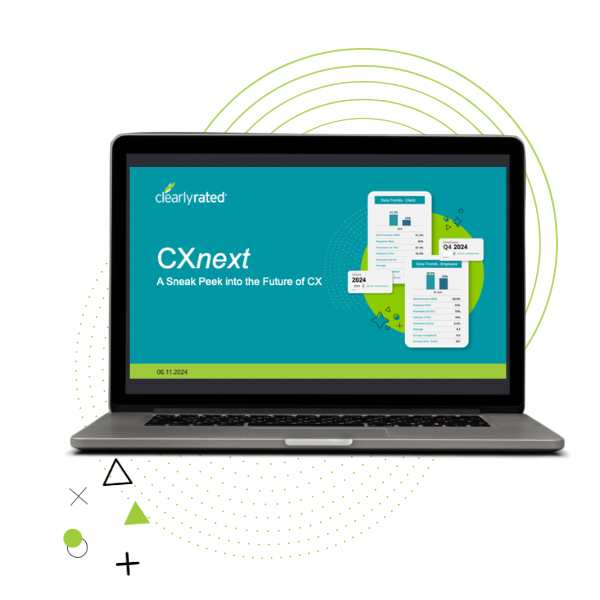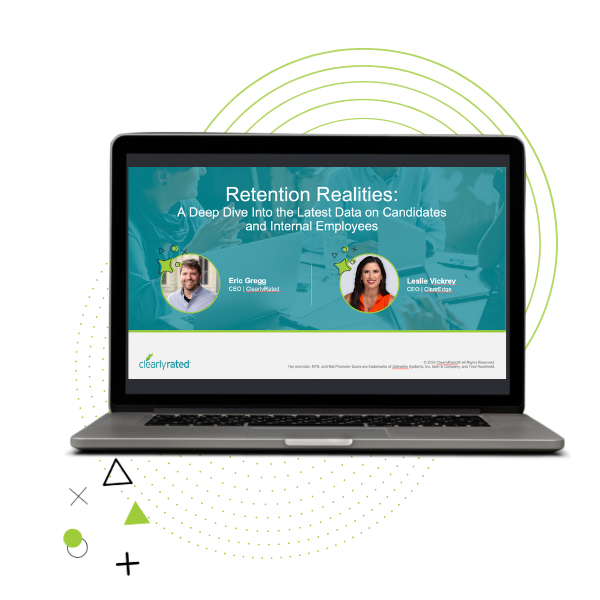When it comes to getting ROI on your customer experience (CX) survey program, response rates play a huge role. Higher response rates paint a fuller picture of your CX. This helps you identify where to improve and, when the feedback is positive, can garner reviews that boost your marketing efforts. Survey programs with high response rates are also more likely to help you identify and re-engage customer accounts that would otherwise be at risk if you hadn’t asked for their feedback.
The bad news? Obtaining good response rates is getting harder.
ClearlyRated Maintains Stable Survey Response Rates Amid Industry Decline

Publicly available data shows that the average response rate for CX programs has been dropping. The above chart illustrates this trend with data shared by three large survey companies including ClearlyRated – the only company showing a slight increase from 2018 to 2022.
B2B survey companies aren’t alone, though. Survey response rates are dropping across industries, affecting public opinion studies and B2C survey programs alike. Why are they dropping? We don’t have a surefire answer, but we have some educated ideas.
Why Are Response Rates Going Down?
Looking at wider email trends, often a main avenue for soliciting survey responses, it’s easy to see that breaking through the crowd is getting more difficult.
In 2022, 333.2 billion emails were sent and received each day, displaying a year-over-year (YOY) increase of 4.2%. So far in 2023, an average of 347.3 billion emails are sent daily – a YOY increase of 4.2% – and the numbers are projected to continue growing as you can see in the chart below.
Total Email Sends Continuously Increasing

Of course, this increase is partially due to the uptick in worldwide email users, but the amount of increased emails sent per user has increased significantly in the last decade. The fact is: The average email user is getting more emails per day every year. And the number of emails sent is inversely related to average response rates. As one number goes up, the other goes down. Email fatigue is real, and many users turn to mass deletions to keep their inboxes under control. This means many email subject lines never get seen, let alone their emails opened and read.
We at ClearlyRated, however, have considered another potential culprit for low response rates: Lack of follow up from surveyors. We work closely with our clients to help them run survey programs that include follow up plans – both during and after survey periods – and we’ve seen short-term and long-term increases in their response rates that boost ROI. So, what can you do with this information to help your organization break ahead of the pack when it comes to response rates?
How to Improve Your Survey Response Rates and Get Better ROI from Your Survey Program
Okay, so now you realize that you’re not alone if you’ve seen lower response rates in your own efforts. Response rates are down across industries. But you don’t have to accept this as your fate. Armed with this information, you can adjust expectations within your organization while also doing everything in your power to keep your response rates as high as possible.
As you can see from the first chart in this blog post, ClearlyRated survey programs enjoy higher response rates than the industry average. We like to think that’s because we’ve identified best practices and care enough to guide our clients in following them. While there’s no silver bullet, here are three ways to boost survey program response rates.
1. Carefully curate your contact list.
The biggest problem we see related to low response rate is that companies pull every email address for every single point of contact they’ve worked with. While they may figure that more email addresses increases their chances for more responses, this practice often negatively affects response rates. That’s because companies that do this end up including client contacts who haven’t worked with them for years, not to mention people who never actually interacted with their services—like someone from accounting who simply paid the bills. So, if you’re facing a low response rate, the first thing you should check is your data set and the criteria you use to create it.
Pull a fresh list, strip it of duplicates and generic email addresses, and then go a step further. Send it to your employees that work directly with your clients to ask them for verification. If possible, integrate your survey tool with your CRM so you’ll be more likely to start with cleaner data. ClearlyRated, for instance, integrates with Bullhorn and Salesforce, with more CRM and ATS integrations, including niche systems, in the works.
2. Educate clients pre-survey and actively engage them during the survey period.
Give your client base a heads up before your survey launch, so they can begin thinking about what they’d like to share and can keep an eye out for their survey invitations. You can do this via mass communication channels and by asking employees in the field to touch base personally—especially for key accounts.
After your survey has launched, watch the response data. Get a list of who hasn’t responded and try to figure out why. Many of our clients have had success by encouraging client-facing employees to check in and ask for survey responses. To help focus your efforts, consider prioritizing your non-response list using financial data. These efforts can encourage an immediate boost in your response rates.
A note when it comes to poor feedback: Don’t sit on it. Act immediately. The ClearlyRated platform, for example, includes a feature for instant sharing to get feedback to the right internal contacts for service recovery.
3. Share results post survey.
Once your survey has closed, go through your data. Identify trends and delve deeply into the comments. Focus on quality and depth of feedback. Learn from it, make positive changes, and then engage your client base by sharing these insights and the actions you’ll take to do better. Use the 2-1-1 formula for client survey follow up: Share two things you’ve learned you’re doing well, one area you found you can improve, and one action you’re taking to make progress on it.
Closing the feedback loop by reporting back to your clients can help increase your response rate over time. When you follow up, it teaches clients that you truly value their feedback and that they can help improve their experience by responding to your surveys. Those who responded will be glad they did and will continue to in the future, while those who didn’t are more likely to answer the next survey. Not only are your program’s response rates likely to increase over time, but client engagement and retention will too. Who knows? Maybe you’ll even buck industry trends and watch your response rates steadily climb.
When you work with an expert provider, they should build these best practices and more into their process, helping their clients achieve higher response rates and more satisfaction data to take action on.





